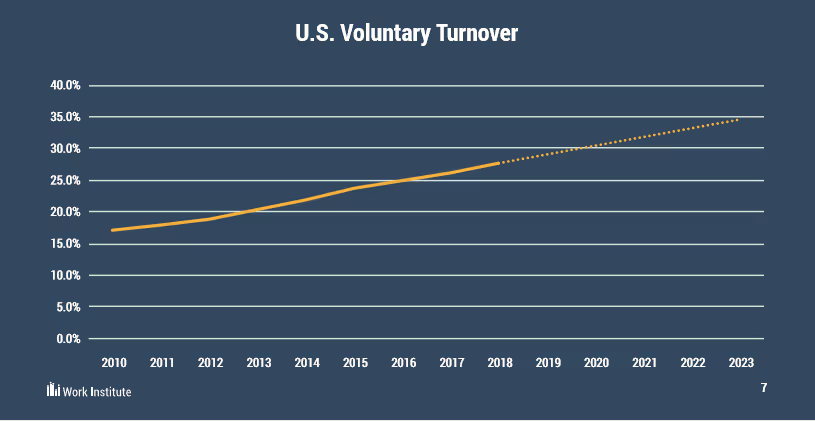According to the World Economic Forum, the speed at which technology is changing is the driving force behind an emerging new labor market. The Fourth Industrial Revolution is upon us, where digital technology and the physical world are blending together to form a new reality. The technology skills needed in the digital revolution are shifting faster than educational degrees can be devised and earned. Skills are thus becoming more valuable than job titles and may become the new metric for evaluating and compensating talent in the labor market in the future.The isn’t a wholly new or unexpected development.
How the War for Talent Has Changed
McKinsey first predicted the War for Talent in 1997. The prediction stipulated that the future would require smart, sophisticated business people who are technologically literate, globally astute, and operationally agile, and that the supply for such talent would not meet the demand. To remain competitive, companies would have to look into nontraditional approaches to recruiting, such as going outside the organization for senior leaders and poaching talent from competitors. This was uncommon at the time, especially for large enterprises, who were finding themselves competing with startups for top technology talent in particular. This situation was expected to last for 20 years.23 years later, the war for talent is still raging. In fact, it’s heating up. Unemployment is at a ten-year low. Employee turnover is at a ten-year high. According to the Work Institute, total workplace turnover in the U.S. ballooned to over 27 percent in 2018 with projections to increase further by 2023.

The war for talent is especially strong for roles in digital technology as organizations everywhere, in every industry, are striving to transform their operations into digital services that provide a better customer experience as well as analytics for the business to continuously improve and strategically grow. However, most organizations don’t have enough people with the skills — such as software engineering, user experience design, or data science — to do everything they want to do.
Can Technology Win the War for Talent?
Unsurprisingly, 83 percent of executives say that talent acquisition is important or very important. Concerns about talent — especially top technology talent — have led many organizations to invest in various talent acquisition and retention strategies, such as developing an employer brand, targeting passive candidates, building deeper talent pools, and modernizing HR, recruitment, and talent management technology and processes (including compensation management software).One rising practice that has recently been gaining appeal at the strategic business level is People Analytics — the use of data analysis, technology, and statistics to revolutionize talent management practices and strategic workforce planning. McKinsey calls the data-driven shift in talent strategy the New War for Talent. Essentially, the concept is to use data analysis and technology to attract and retain top talent with skills in data analysis and technology so that the organization can get ahead in data analysis and technology. This is particularly true in Silicon Valley and technology companies where poaching technology talent is a business necessity. However, it is also seeing adoption elsewhere.People Analytics, like much of digital transformation, requires leveling up technology skills in the HR department, not just in IT. And that’s exactly what is happening, if not at the speed required for organizations to realize the full benefits of people analytics. Nevertheless, LinkedIn’s Global Talent Trends for 2020 found a 242 percent increase in HR professionals with data analysis skills over the last 5 years.There is a caution, though. The trend toward using predictive data analytics and technology for talent acquisition and retention means accepting that automation may eventually replace jobs as machines become better at recruiting than humans. Indeed, the National Bureau of Economic Research studied 300,000 hires for high-turnover jobs and found that algorithms are better at predicting good hires than humans. The people picked by computers stayed longer on average and performed just as well or better than the people selected by recruiters. Likewise, analysis from the University of Minnesota found that a simple equation outperforms human evaluation of candidates by 25 percent, which was true regardless of the job level (including the C-suite).However, people analytics is not fully mature at present. Deloitte’s fifth annual Global Human Capital Trends report and survey found that people analytics has grown in significance to become a serious business discipline, but only 8 percent of organizations report having usable data and only 9 percent of companies believe they have a good understanding of the talent factors that drive performance. Analysis published in the November-December 2019 issue of the Harvard Business Review suggests that an increased focus on the Relational Analytics can help businesses cross the chasm, but the technology is still evolving.
Upskilling as an Alternative to Talent Acquisition
As matters stand now, there isn’t enough highly skilled technology talent to go around — and that doesn’t look like it is going to change in the near future. One possible way to sidestep the War for Talent is to refocus on the talent you already have through better employer branding and retention strategies and upskilling the current workforce to occupy new and emerging roles. According to data from LinkedIn’s Global Talent Trends for 2020, internal recruiting is making a comeback, with role changes within an organization having increased 10 percent over the last five years. LinkedIn also found that employees stay 41 percent longer at companies that do a lot of internal hiring compared to companies with low internal hiring.CEOs are aware of the business necessity and promise of upskilling current employees, but few have acted on it. PwC’s 23rd annual CEO Survey for 2020 found that CEOs believe upskilling programs for workers are important. However, only 8 percent of US CEOs cite significant progress in establishing an upskilling program. For those that made the investment, only 17 percent say that their upskilling programs have been “very effective” in achieving higher workforce productivity while 20 percent say that upskilling has been “very effective” in accelerating digital transformation.Upskilling employees is a significant investment. The fear that upskilling programs won’t be successful is a strong deterrent, whether it’s because the chosen program is deficient, employees aren’t able to learn the top technology skills required to successfully do the jobs that the organization needs done, or because they won’t be able to do those jobs as well as external talent that can be poached faster and more cost effectively. Another fear is that after investing a considerable amount in education to upskill the current workforce, the best employees will be enticed away to companies offering more compensation for those skills.This is a serious dilemma. The employer likely views the investment it makes in upskilling programs as compensation for the employees that enroll in and benefit from those programs. For example, the organization might deepen investment in Learning and Development (L&D) to modernize corporate training, pay for certification classes, or partner with universities for employees to take courses at employer-sponsored discounts. However, once the employee has learned new skills — and if those skills make them more valuable in the marketplace — that employee is incentivized to jump ship.When turnover like this happens, it can feel like betrayal to the employer, who invested in upskilling programs specifically in order to retain employees and utilize their skills to help them compete. But to the employee, foregoing compensation for highly valuable skills can be a costly mistake to one’s long-term life planning that compounds over time. This is especially true for top technology skills that may only be hot in the job market for a few years. This is the reality of many programming languages, which evolve constantly and can command premium pay at the top of their lifecycle.So what is the answer?One thing you can do is arm your organization with data on which skills are earning higher compensation on the open market — and by how much. At minimum, this allows employers to make informed decisions in their compensation planning for top technology skills. Compensating employees more for specific skills that are in high demand is similar to compensating employees more for living in geographical locations with a higher cost of living. Not every organization does this, but it’s considered a compensation best practice when determined strategically with up-to-date salary market data.
The Top Technology Skills Commanding Higher Salaries Right Now in 2020
According to PayScale’s data team, the top compensable skills in PayScale’s Differential Engine at the time of this article are all technology skills except for one. The Differentials Engine is a software feature accessible with PayScale MarketPay that uses a decade's worth of validated salary data combined with machine learning to surface insights on how skills and geographical location impact compensation. It also provides the ability to apply the differential on top of external data to more accurately price jobs.The below is a snapshot in time of the top 15 skills across all industries that are statistically relevant based on the number of appearances in job descriptions along with the percentage increase in compensation that each incurs. Skills data is refreshed every two weeks.
Top Compensable Skills
Type of Skill
Comp Increase
Distributed SystemsTechnology26.24%Elixir (Programming Language)Technology24.48%Go (Golang) (Programming Language)Technology21.36%Clojure (Programming Language)Technology19.13%KubernetesTechnology19.06%iOS SDK (Mobile Development)Technology18.89%Artificial Intelligence (AI)Technology18.22%Scala (Programming Language)Technology17.64%Algorithm DevelopmentTechnology17.53%Kotlin (Programming Language)Technology17.11%Apache KafkaTechnology16.34%Mergers and AcquisitionsFinance15.65%Amazon Web Services (AWS)Technology14.49%Object Oriented Programming (OOP)Technology14.39%Ruby on RailsTechnology14.34%Obviously, there is nuance to this. Most technologists have more than one technology skill and you wouldn’t just add up all the compensation increases for each skill an individual has. There are also differences in experience with each technology as well as experience generally within a job role or industry that might weigh more heavily in compensation than skills alone. In other words, the percent increase in compensation for a specific skill depends on the base compensation that an individual employee already has. When adding all compensable factors together, a particular skill may or may not shift compensation for an individual employee. This is where compensation management software that crunches all the compensable factors for you can be really helpful.
What Are Pay Communications and How do you Improve Them?
Of course, for organizations that are unable or unwilling to provide additional compensation for top technology skills, whether they were learned on the company dime or independently by the employee, you can still retain highly skilled and qualified talent through improved pay communications. Pay communications are the policies and processes that your organization uses to explain to employees why they are paid the way they are. For example, it’s important to break down total rewards packages with employees so that they understand the benefits that a company provides, especially investments in employee education and upskilling that may not be of obvious to the employee without this communication. This may be all it takes. In a previous research report, PayScale found that when a rationale is provided, 82 percent of employees are satisfied with their pay even when they make less than the market average for a position.Ultimately, what matters is that organizations are thinking ahead about the talent and skills they are going to need to be competitive in the future. Right now, no one knows what skills are going to be in demand down the road or what new jobs might exist in the future. Things are changing too quickly, especially in technology. What we do know is that the War for Talent isn’t going to let up in the near future. Organizations that don’t implement concrete plans to win on talent by investing in recruiting strategies, retention strategies, upskilling, or all of the above are going to fall behind and possibly disappear.







